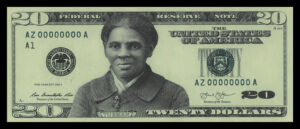
Who and what we depict on our banknotes and coins is always an expression of national identity. And the identity of the USA has struggled for some years now, we often read of a deeply divided nation. Therefore, a question like who to feature on a banknote can become a major political debate.
But let’s start at the beginning. In 2015, the Obama administration wanted to know who the people of the USA would like to see on a banknote in the future. For some time, there had been calls for a woman to be depicted on one of the banknotes. They finally decided to choose the Afro-American Harriet Tubman, who fought for the freedom of slaves, over candidates such as Eleanor Roosevelt and Rosa Park. At first, it was planned that Tubman was to be featured on 10$ notes. However, in that very year the person depicted on that banknote became so popular that a replacement was out of the question – we are talking about Alexander Hamilton, the hero of a musical that premiered in 2015.

So in 2016 it was decided that Harriet Tubman would be depicted on the obverse of the $20 note instead, replacing President Andrew Jackson, who was to appear on the reverse along with the White House. First drafts became known and the notes were supposed to be printed as early as in 2020. But things turned out differently – Donald J. Trump entered the stage. Already during the election campaign, he maintained that the project was “pure political correctness”. Trump claimed to be a great fan of Andrew Jackson and had a painting of him be displayed in the Oval Office. During his presidency, the Tubman project was postponed again and again – to 2026, 2028 and finally to 2030.
A Banknote as a Political Issue
For the half of the American population that considers Trump a racist and misogynist, this was no coincidence. During Trump’s time in office, there was repeated unrest; for the #MeToo and Black Lives Matter movements the postponement of Tubman banknotes was a symbol for Trump’s regressive policies and the realization of the project an important symbol for change.

Initiatives such as Tubman20 and Women on 20s campaigned for the new design and started petitions. Artists and activists distributed self-made Tubman banknotes, some with clear political demands. And again and again, $20 notes appeared and continue to appear on which the portrait of Jackson was overstamped with that of Tubman or a stamp of Tubman placed next to it – which is obviously problematic from the legal point of view. At the same time, other groups demanded Jackson to remain on the banknotes.
Wer waren Tubman und Jackson?

I’m sure many readers that aren’t from the United States are wondering who Tubman and Jackson were. A brief digression.
Harriet Tubman was born around 1820 as a slave on a plantation in Maryland. In 1849 she escaped from slavery and from then on, at constant risk of her own life, helped other slaves to escape from the southern states to the north, where slavery had already been abolished. She is the most famous member of the Underground Railroad network, which freed about 100,000 slaves prior to the Civil War. During the war, Tubman worked for the Union as a scout, spy and nurse. After the Civil War, she campaigned for women’s rights. Today, the extraordinary woman is considered an American hero.

And who is the man she is supposed to replace? It is no coincidence that it is Andrew Jackson.
The seventh president of the United States is, at least here in Europe, less well known than many other presidents on the banknotes. He was co-founder of the Democratic Party (which stood for completely different political values at the time), is considered a war hero and was the first president not to come from the American “aristocracy”. However, Old Hickory, as he was nicknamed, is quite a controversial figure. Besides his autocratic political style, this is mainly due to the fact that the Trail of Tears began under his administration in 1830: about 100,000 native Americans were deported from their settlement areas to reservations, which directly resulted in thousands of deaths. Moreover, he was a slave owner himself. The symbolic power of replacing him with the former slave Tubman is obvious.
What’s Next?
The entire debate demonstrates wonderfully how much symbolic power cash and its design still has today. Now, Trump’s presidency is over. Joe Biden announced in January that the process of redesigning the banknote will be resumed and that they would work out how to implement the new design as quickly as possible. Other “restaffing” on notes have also been discussed since 2016. Will they be just as controversial? We will keep you updated!
We already reported on the planned new design in 2016.
Wikipedia, for example, knows more about the extraordinary life of Harriet Tubman.
The websites of initiatives such as Tubman20 and Women On 20s tell you more about their objectives and the political dimensions of the case. You can also buy fake notes and stamps there.
And if we made you curious about the musical Hamilton: here you can watch the opening on YouTube.



